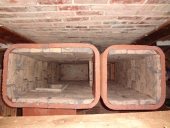If you have IBS or other upset (such as Crohn's but I haven't read about that specifically) it is highly likely that you are not getting along with the microbial ecosystem residing in your large intestine. A microbial mafia has probably got the place locked down, to the detriment of your health.
Have a look into "resistant starch." It is starch that is indigestible by humans and therefore makes it into the large intestine intact, where it acts as food for our microbial allies, such as bifidobacteria. It is probably the most important food/gut related discovery of the last 20-30 or however many years.
The number one source of resistant starch is raw potatoes. Another good source is cooked and cooled potatoes. Cooking destroys the starch in its raw form, but what's called "retrograde" resistant starch forms during the cooling process. Both raw (RS2) and retrograde (RS3) are highly beneficial.
Resistant starch appears to have been a critical part of our ancestral diets and very important to our evolution. For example we even have cellular receptors in the lining of the intestines that are activated directly by RS2. Yet it is nearly absent from the typical modern diet.
The world leader in resistant starch information is ordinary-guy Tim Steele, who has a blog
https://potatohack.com/ and put together the book "Potato Hack" which is an enjoyable read. The potato hack is a weight-loss method where you eat only potatoes for 2-3 days every now and then. Seems to work for a lot of people, and not just for weight-loss. Check the Amazon reviews for interesting testimonials.
Although resistant starch is fermentable, it isn't an ODMAP so it isn't technically a FODMAP, even though it is similar. The low-FODMAP diet may help with symptoms in the short-term but it is no way to eat in the long-term because it starves your large intestine microbial enemies at the cost of also starving your microbial allies. From the potato hack blog (
https://potatohack.com/2016/12/27/potato-diet-prebiotic-probiotic):
A well-fed large intestine may weigh 6-10 pounds when full. A dehydrated, low-carb, fiber-poor large intestine may only weigh half that.
For health you want a flourishing large intestinal community just like you want a flourishing microbial community in your garden soil. Carpet-bombing or starving your large intestine kills the microbe-mafia and reduces symptoms of illness the same way carpet-bombing the soil or using a sterile growing medium can temporarily reduce pests and disease in your crops.
I think resistant starch is to your gut the way carbon is to the soil. If you only have the time to focus on one thing for your soil, add more carbon. Similarly, if you only have the mental space to think about one thing for your gut health, or overall health even, plow resistant starch into your diet (or "mulch" with resistant starch if you prefer, don't want to trigger anyone especially giant men named Paul).
Keep in mind I am not a doctor (thank goodness), I only play one to friends and family.











